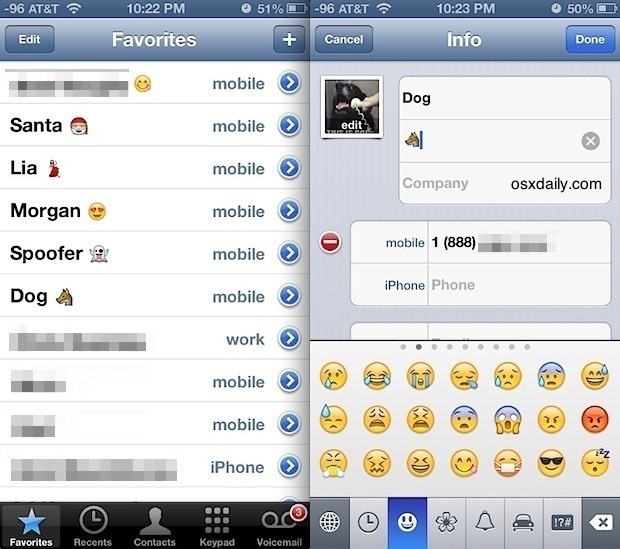Stylize Contacts & Names on the iPhone By Adding Emoji Characters
Adding Emoji to contacts names on the iPhone is a fun way to stylize individual contacts and to bring an additional layer of customization to iOS. Other than being fun looking, it can also help to quickly identify names in the contacts list, get an additional visual indicator of who sent a text message, and the emoticons even show up with incoming and outbound phone calls.
![]()
Before making modifications to your Contacts list, it’s usually a good idea to back them up first. Though it’s extremely unlikely for something to go awry, it only takes a moment to do and in the event you accidentally delete something, mess up a name or two, or decide you dislike the emoji customizations, you’ll be able to restore back to normal again. Once you’ve done that, jump ahead and start customizing your contacts.
Add Emoji to Contact Names in iOS
We’re focusing on the iPhone in the walkthrough, but technically this works the same on the iPad and iPod touch as well:
- Enable the optional Emoji keyboard through iOS Settings if you haven’t done so yet
- Open the Contacts app, or open Phone and choose the “Contacts” tab
- Tap the “Edit” button, then choose any contact name to modify it
- Tap on one of the name sections, then summon the Emoji keyboard by tapping the globe icon, choosing an emoji icon to stylize the contacts name with
- Select “Done” when finished
- Repeat with other contacts as desired

I prefer to add the emoji icons to the end of a contact name, which means adding them to the “Last Name” portion of the contact, but you can obviously prefix names with them too by adding it before the first name entry.
It’s worth mentioning that adding emoji icons to names can change how they are sorted in the overall Contacts list, which defaults to using the alphabetical listing and grouping. You will find that where contacts wind up in the listing can change depending on where the emoji is placed, which is yet another reason that placing the characters at the end of a last name is a good idea, otherwise the icon itself will be interpreted as the first name or last name.
Here is an example of how this looks when you get an inbound iMessage from someone whose name has been stylized by an emoji:

Assuming you use different emojicons for each name, it becomes very easy to know who is sending a message even if you can’t read the name because the phone is at a distance. While you’re on a customization kick, it’s also helpful to differentiate people with auditory cues by setting unique text tones and distinct ring tones for each individual, if not for everyone than at least those on the “Favorites” list.
Because OS X and iOS share emoji characters, you could also make these name customizations from the Mac Contacts app and then let iCloud sync them over to the iPhone and iPad. Keep in mind that the newest versions of iOS do contain a few more characters than the Mac emoticon dictionary, meaning you’ll ultimately have more options if you perform these modifications from the mobile world.
Thanks to Chelsea for showing us this fun trick. Got a fun tip or trick you want to share? Hit us up on Twitter, Facebook, Google+, or email – comments are temporarily disabled

